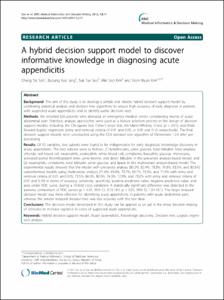KUMEL Repository
1. Journal Papers (연구논문)
1. School of Medicine (의과대학)
Dept. of Internal Medicine (내과학)
A hybrid decision support model to discover informative knowledge in diagnosing acute appendicitis
- Keimyung Author(s)
- Jang, Byoung Kuk; Kim, Yoon Nyun
- Department
- Dept. of Internal Medicine (내과학)
- Journal Title
- BMC Medical Informatics and Decision Making
- Issued Date
- 2012
- Volume
- 12
- Issue
- 1
- Abstract
- BACKGROUND:
The aim of this study is to develop a simple and reliable hybrid decision support model by combining statistical analysis and decision tree algorithms to ensure high accuracy of early diagnosis in patients with suspected acute appendicitis and to identify useful decision rules.
METHODS:
We enrolled 326 patients who attended an emergency medical center complaining mainly of acute abdominal pain. Statistical analysis approaches were used as a feature selection process in the design of decision support models, including the Chi-square test, Fisher's exact test, the Mann-Whitney U-test (p < 0.01), and Wald forward logistic regression (entry and removal criteria of 0.01 and 0.05, or 0.05 and 0.10, respectively). The final decision support models were constructed using the C5.0 decision tree algorithm of Clementine 12.0 after pre-processing.
RESULTS:
Of 55 variables, two subsets were found to be indispensable for early diagnostic knowledge discovery in acute appendicitis. The two subsets were as follows: (1) lymphocytes, urine glucose, total bilirubin, total amylase, chloride, red blood cell, neutrophils, eosinophils, white blood cell, complaints, basophils, glucose, monocytes, activated partial thromboplastin time, urine ketone, and direct bilirubin in the univariate analysis-based model; and (2) neutrophils, complaints, total bilirubin, urine glucose, and lipase in the multivariate analysis-based model. The experimental results showed that the model with univariate analysis (80.2%, 82.4%, 78.3%, 76.8%, 83.5%, and 80.3%) outperformed models using multivariate analysis (71.6%, 69.3%, 73.7%, 69.7%, 73.3%, and 71.5% with entry and removal criteria of 0.01 and 0.05; 73.5%, 66.0%, 80.0%, 74.3%, 72.9%, and 73.0% with entry and removal criteria of 0.05 and 0.10) in terms of accuracy, sensitivity, specificity, positive predictive value, negative predictive value, and area under ROC curve, during a 10-fold cross validation. A statistically significant difference was detected in the pairwise comparison of ROC curves (p < 0.01, 95% CI, 3.13-14.5; p < 0.05, 95% CI, 1.54-13.1). The larger induced decision model was more effective for identifying acute appendicitis in patients with acute abdominal pain, whereas the smaller induced decision tree was less accurate with the test data.
CONCLUSIONS:
The decision model developed in this study can be applied as an aid in the initial decision making of clinicians to increase vigilance in cases of suspected acute appendicitis.
- Publisher
- School of Medicine
- Citation
- Chang Sik Son et al. (2012). A hybrid decision support model to discover informative knowledge in diagnosing acute appendicitis. BMC Medical Informatics and Decision Making, 12(1), 17–17. doi: 10.1186%2F1472-6947-12-17
- Type
- Article
- ISSN
- 1472-6947
- Appears in Collections:
- 1. School of Medicine (의과대학) > Dept. of Internal Medicine (내과학)
- 파일 목록
-
-
Download
 oak-aaa-00668.pdf
기타 데이터 / 434.8 kB / Adobe PDF
oak-aaa-00668.pdf
기타 데이터 / 434.8 kB / Adobe PDF
-
Items in Repository are protected by copyright, with all rights reserved, unless otherwise indicated.